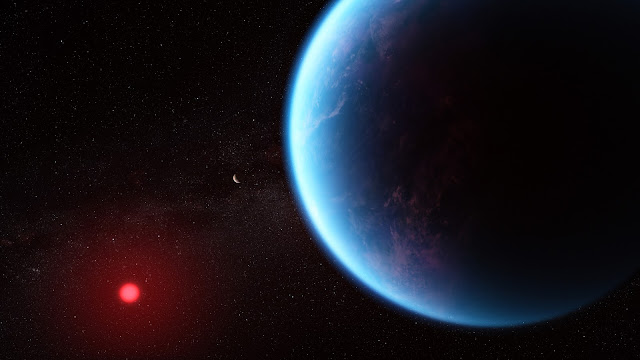Webb Discovers Methane & Carbon Dioxide in Atmosphere of Exoplanet K2-18 b
This artist’s concept shows what exoplanet K2-18 b could look like based on science data. K2-18 b, an exoplanet 8.6 times as massive as Earth, orbits the cool dwarf star K2-18 in the habitable zone and lies 120 light-years from Earth.
Spectra of exoplanet K2-18 b
A new investigation with the NASA/European Space Agency/Canadian Space Agency James Webb Space Telescope into exoplanet K2-18 b has revealed the presence of carbon-bearing molecules, including methane and carbon dioxide. The abundance of methane and carbon dioxide, and shortage of ammonia, support the hypothesis that there may be an ocean underneath a hydrogen-rich atmosphere in K2-18 b.
While K2-18 b lies in the habitable zone and is now known to harbor carbon-bearing molecules, this does not necessarily mean that the planet can support life. The planet's large size—with a radius 2.6 times the radius of Earth—means that the planet’s interior likely contains a large mantle of high-pressure ice, like Neptune, but with a thinner hydrogen-rich atmosphere and an ocean surface. Hycean worlds are predicted to have oceans of water. However, it is also possible that the ocean is too hot to be habitable or be liquid.
"Although this kind of planet does not exist in our solar system, sub-Neptunes are the most common type of planet known so far in the galaxy," explained team member Subhajit Sarkar of Cardiff University. "We have obtained the most detailed spectrum of a habitable-zone sub-Neptune to date, and this allowed us to work out the molecules that exist in its atmosphere.”
Image 1 Description: Illustration of an exoplanet planet and its red cool dwarf star on a black background that is speckled with some small stars.
Image 2 Description: The graphic shows the spectra of the exoplanet K2-18 b from NIRISS and NIRSpec in the form of a graph, with the vertical y-axis labelled as Amount of Light Blocked and the horizontal axis labelled as Wavelength of Light (microns). The spectra is plotted as dots with vertical short vertical lines across the plot, with the best-fit model as a blue jagged white line.There are green, yellow and light blue vertical columns of varying thicknesses scattered across the plot indicating where variations in the line represent the presence of methane, carbon dioxide, and dimethyl sulphide, respectively.
Credit: NASA, CSA, ESA, J. Olmstead (STScI), N. Madhusudhan (Cambridge University)
Release Date: Sept. 11, 2023
#NASA #ESA #Astronomy #Space #Science #Star #K218 #Exoplanet #K218b #Atmosphere #CarbonDioxide #Methane #Leo #Constellation #JamesWebbSpaceTelescope #JWST #Cosmos #Universe #UnfoldTheUniverse #Europe #CSA #Canada #JPL #GSFC #STScI #UnitedStates #Art #Illustration #Infographic #STEM #Education
.jpg)



APoD.jpg)

.jpg)
.jpg)
.jpg)


